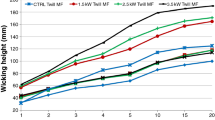Abstract
This study reports on the deposition of a hydrophobic coating on polyurethane (PU)-based synthetic leather through a plasma polymerization method and investigates the hydrophobic behavior of the plasma-coated substrate. The silicon compound of hexamethyldisiloxane (HMDSO), inactive gas argon (Ar), and toluene were used to impart surface hydrophobicity to a PU-based substrate. Surface hydrophobicity was analyzed by water contact angle measurements. Surface hydrophobicity was increased by deposition of compositions of 100% HMDSO, 3:1 HMDSO/toluene, and 1:1 HMDSO/toluene. Optimum conditions of 40 W, 30 s plasma treatment resulted in essentially the same initial contact angle results of approximately 100° for all three treatment compositions. The initial water contact angle for untreated material was about 73°. A water droplet took 1800 s to spread out on the plasma-treated sample after it had been placed on the sample surface. An increase in plasma power also led to a decrease in contact angle, which may be attributed to oxidization of HMDSO during plasma deposition. XPS analysis showed that plasma polymerization of HMDSO/toluene compositions led to a significant increase in atomic percentage of Si compound responsible for the hydrophobic surface. The easy clean results for the treated and untreated PU-based synthetic leather samples clearly showed that the remaining stain on the plasma-polymerized sample was less than that of untreated sample. The plasma-formed coating was both hydrophobic and formed a physical barrier against water and stain.







Similar content being viewed by others
References
Ji, YY, Kim, SS, Kwon, OP, Lee, SH, “Easy Fabrication of Large-Size Superhydrophobic Surfaces by Atmospheric Pressure Plasma Polymerization with Non-Polar Aromatic Hydrocarbon in an In-Line Process.” Appl. Surf. Sci., 255 4575–4578 (2009)
Blossey, R, “Self-cleaning Surfaces—Virtual Realities.” Nat. Mater., 2 301–306 (2003)
Kim, MH, Kim, KH, Lee, NY, Shin, KS, Kim, YS, “Surface Modification of Polyimide Films, Filter Papers, and Cotton Clothes by HMDSO/Toluene Plasma at Low Pressure and Its Wettability.” Chem. Commun., 9 1223–1226 (2007)
Prasad, AK, “Novel Effects in Garment Processing and Value Added Finishes.” J. Text. Assoc., May–June, 39–42 (2007)
Oner, D, McCarthy, TJ, “Ultrahydrophobic Surfaces. Effects of Topography Length Scales on Wettability.” Langmuir, 16 7777–7782 (2000)
Liu, Y, Chen, X, Xin, JH, “Super-Hydrophobic Surfaces from a Simple Coating Method: A Bionic Nanoengineering Approach.” Nanotechnology, 17 3259–3263 (2006)
Cho, SC, Hong, YC, Uhm, HS, “Hydrophobic Coating of Carbon Nanotubes by CH4 Glow Plasma at Low Pressure, and Their Resulting Wettability.” J. Mater. Chem., 17 232–237 (2007)
Guido, G, Matthias, B, Petra, T, “In Situ Spectroscopic and Corrosion Studies of Ultra-Thin Gradient Plasma Polymer Layers on Zinc in Situ Spectroscopic and Corrosion Studies of Ultra-Thin Gradient Plasma Polymer Layers on Zinc.” Appl. Surf. Sci., 217 223–232 (2003)
Arefi, F, Andre, V, Montazer-Rahmati, P, Amouroux, J, “Plasma Polymerization and Surface Treatment of Polymers.” Pure Appl. Chem., 64 715–723 (1992)
Hiratsuka, A, Karube, I, “Plasma Polymerized Films for Sensor Devices.” Electroanalysis, 12 695–702 (2000)
Martin, Y, Boutin, D, Vermette, P, “Study of the Effect of Process Parameters for N-Heptylamine Plasma Polymerization on Final Layer Properties.” Thin Solid Films, 515 6844–6852 (2007)
Kühn, G, Retzko, I, Lippiz, A, Unger, W, Friedrich, J, “Homofunctionalized Polymer Surfaces Formed by Selective Plasma Processes.” Surf. Coat. Technol., 142–144 494–500 (2001)
Kasih, TP, Kuroda, S, Kubota, H, “Poly(methyl methacrylate) Films Deposited Via Non-Equilibrium Atmospheric Pressure Plasma Polymerization Using Argon as Working Gas.” Plasma Process. Polym., 4 648–653 (2007)
Li, S, Jinjin, D, “Improvement of Hydrophobic Properties of Silk and Cotton by Hexafluoropropene Plasma Treatment.” Appl. Surf. Sci., 253 5051–5055 (2007)
Hodak, SK, Supasai, T, Paosawatyanyong, B, Kamlangkla, K, Pavarajarn, V, “Enhancement of the Hydrophobicity of Silk Fabrics by SF6 Plasma.” Appl. Surf. Sci., 254 4744–4749 (2008)
Kamlangkla, K, Paosawatyanyong, B, Pavarajarn, V, Hodak, JH, Hodak, SK, “Mechanical Strength and Hydrophobicity of Cotton Fabric after SF6 Plasma Treatment.” Appl. Surf. Sci., 256 5888–5897 (2010)
Cicala, G, Milella, A, Palumbo, F, Favia, P, d’Agostino, R, “Morphological and Structural Study of Plasma Deposited Fluorocarbon Films at Different Thicknesses.” Diam. Relat. Mater., 12 2020–2025 (2003)
Rinsch, CL, Chen, C, Panchaligam, V, Eberhart, RC, Wang, JH, Tonnons, RB, “Pulsed Radio Frequency Plasma Polymerization of Allyl Alcohol: Controlled Deposition of Surface Hydroxyl Groups.” Langmuir, 12 2995–3002 (1996)
Clarson, SJ, Semlyen, JA, Siloxane Polymers. Prentice Hall, Englewood Cliffs, 1993
Ji, YY, Hong, YC, Lee, SH, Kim, SD, Kim, SS, “Formation of Super-Hydrophobic and Water-Repellency Surface with Hexamethyldisiloxane (HMDSO) Coating on Polyethyleneteraphtalate Fiber by Atmosperic Pressure Plasma Polymerization.” Surf. Coat. Technol., 202 5663–5667 (2008)
Morent, R, Geyter, ND, Vlierberghe, SV, Dubruelb, P, Leys, C, Gengembre, L, Schacht, E, Payen, E, “Deposition of HMDSO-Based Coatings on PET Substrates Using an Atmospheric Pressure Dielectric Barrier Discharge.” Prog. Org. Coat., 64 304–310 (2009)
Acknowledgments
This work was supported by the Istanbul Technical University Scientific Research Projects Fund under Grant No. BAP–34137. State Planning Organization (DPT) of Turkey is acknowledged for the support of UNAM-Institute of Materials Science and Nanotechnology. The authors would like to thank Flokser Tekstil San. Tic. A.S company for the supply of raw materials.
Author information
Authors and Affiliations
Corresponding author
Rights and permissions
About this article
Cite this article
Kayaoglu, B.K., Ozturk, E., Guner, F.S. et al. Improving hydrophobicity on polyurethane-based synthetic leather through plasma polymerization for easy care effect. J Coat Technol Res 10, 549–558 (2013). https://doi.org/10.1007/s11998-013-9470-x
Published:
Issue Date:
DOI: https://doi.org/10.1007/s11998-013-9470-x




